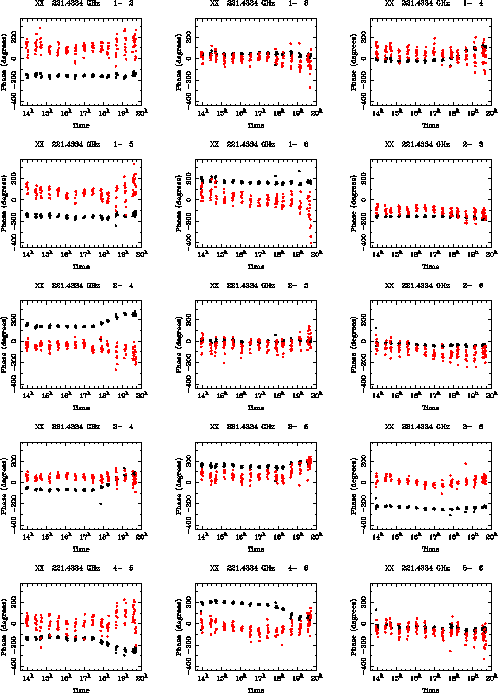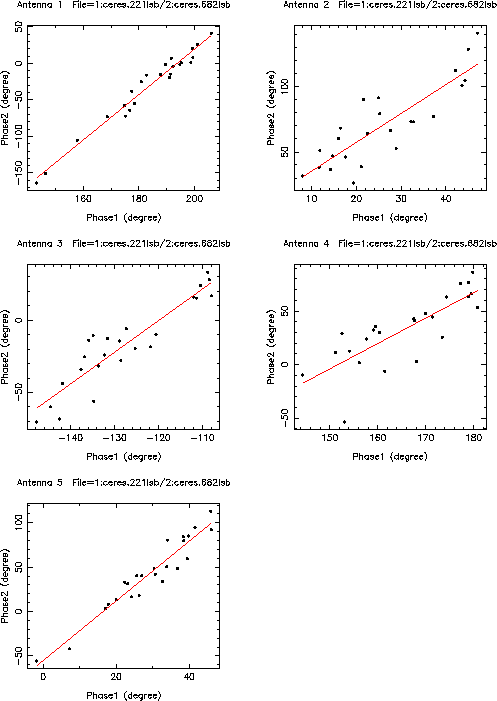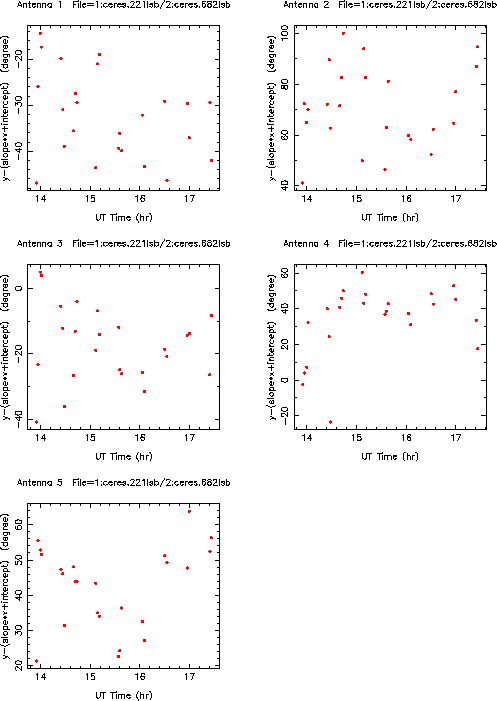yaxis = slope * xaxis + intercept
D(yaxis) = slope * D(xaxis) + intercept
where D() is the difference between succesive samples,
xaxis, yaxis are the uv variables from single uvfiles.
In addition, varfit
provides an option of regression for
the phases derived from the gains of two uvfiles.
If either axis is an antenna gain, then selfcal
must be run first
and the axes are sampled at the interval used in selfcal.
For linear regression between the two phase solutions, the setup
in the selfcal
for the two simultaneously sampled data files needs
identical. The rms and correlation coefficient are listed for
each antenna.
varfit
is a useful tool for analysis of the data obtained from
observations at 230/690 GHz, simultaneously. An exmaple is shown to do
linear regression between the phases derived from 230 and 690 GHz data sets
based on the observations of Ceres on Feb 18, 2005 during the 690 GHz campaign.
Ceres, ![]() 0.5 arcsec in size, was observed for 3.5 hrs at both lsb and usb.
Here is the procedure to extract data from the raw SMA archival data:
0.5 arcsec in size, was observed for 3.5 hrs at both lsb and usb.
Here is the procedure to extract data from the raw SMA archival data:
1. Loading data:
\rm -r miriad050218_230_rx0.lsb
smalod in=/home/miriad/SMAdata/050218_04:23:14/ out=miriad050218_230 rxif=0 \
sideband=0 options=dospc rsnchan=, \
nscans=0,
\rm -r miriad050218_690_rx2.lsb
smalod in=/home/miriad/SMAdata/050218_04:23:14/ out=miriad050218_690 rxif=2 \
sideband=0 options=dospc rsnchan=, \
nscans=0,
2. Qvack the first integrations after switching source:
qvack vis=miriad050218_230_rx0.lsb interval=0.5 mode=source qvack vis=miriad050218_690_rx2.lsb interval=0.5 mode=source3. Uvsplit ceres data from the multi-source files:
uvsplit vis=miriad050218_230_rx0.lsb select='source(ceres)' options=nowindow uvsplit vis=miriad050218_690_rx2.lsb select='source(ceres)' options=nowindow rename the file names: mv ceres.221381 ceres.221lsb mv ceres.682534 ceres.682lsb4. Uvplt the two data sets together:
uvplt vis=ceres.221lsb,ceres.682lsb axis=time,pha options=nocal,unwrap \
device=/xs nxy=3,5
 |
5. Flag problematic data due to instruments:
There is a large phase drift on the baselines related to antenna 4 in the last 2.5 hrs of the observation at 221 GHz, which is apparently due to the instrument and mars the linear correlation between 221 GHz and 682 phases. To make the data sampling in the two files (221/682) identical, we flag all the antennas in the last 2.5 hrs for both files.
uvflag vis=ceres.221lsb select='time(17:27,23:00)' flagval=flag uvflag vis=ceres.682lsb select='time(17:27,23:00)' flagval=flag6. Selfcal to derive antenna-based phase:
selfcal vis=ceres.221lsb interval=3 refant=6 line=chan,1,1,3072 selfcal vis=ceres.682lsb interval=3 refant=6 line=chan,1,1,30727. Varfit for linear regression of the 221/682 phases:
Input:
Task: varfit vis = ceres.221lsb,ceres.682lsb xaxis = time yaxis = phase log = device = /xs nxy = 2,3 xrange = yrange = refant = 6 refant2 = options = phareg
Report on screen:
Number of points= 24 Telescope: SMA Longitude: 3.56959983 Latitude: 0.34599766 yaxis = phase2 derived from gains of FILE1: ceres.682lsb xaxis = phase1 derived from gains of FILE2: ceres.221lsb yaxis = slope * xaxis + intercept ant yaxis_ave yaxis_rms slope intercept rms-fit correlation 1 -32.2616653 51.0761375 3.11044097 -602.588867 9.25224018 0.983457565 2 70.8661575 30.2317333 2.21507621 13.0970154 15.5836172 0.856906891 3 -17.2317696 28.9356842 2.18647981 262.041107 11.3366861 0.920056641 4 33.2323456 31.7655563 2.36979771 -359.516388 19.324564 0.793668747 5 42.4374352 40.2758331 3.36416936 -55.4049721 11.4256344 0.958917618 D(yaxis) = slope * D(xaxis) + intercept ant yaxis_ave yaxis_rms slope intercept rms-fit correlation 1 8.04884434 50.8008919 3.14248133 -1.13375735 13.0757828 0.966306806 2 9.50405884 30.7449551 2.18931246 2.78468132 20.3906422 0.748425245 3 8.4316721 29.0480194 2.5807817 0.697852492 11.4700851 0.918738604 4 6.80336809 32.7231979 2.22708535 1.3551662 19.3240604 0.807015002 5 8.01961803 40.3351746 2.75186563 1.23834038 11.2498817 0.960317194
Plots the linear regression of 690/230 phases:
 |
Plots the variation of the residual phase:
 |